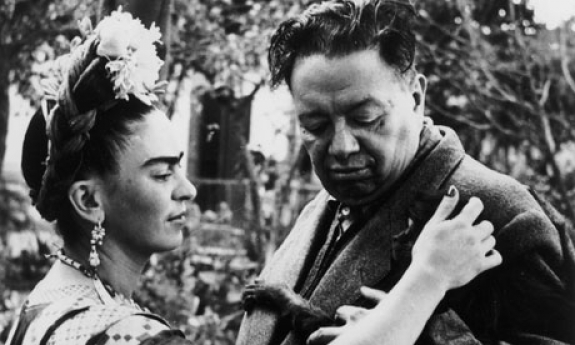Fridamania last hit Britain in 2005, the year of Tate Modern's big retrospective. The nation was smitten, just as Frida Kahlo's husband Diego Rivera and all her other lovers had been during her lifetime. We were dripping in Frida earrings and Frida hairpieces; we were knee-deep in Frida dolls and Frida-inspired skirts. And, of course, there were all those extraordinary self-portraits to look at.
Six years on, Kahlo is back, one half of an exhibition that opens at Pallant House in Chichester next week, showing alongside Rivera's work; it is the first time the couple have been exhibited together in the UK.
In their lifetime, there was little debate over who was the greater artist. Rivera, who retold the turbulent narrative of Mexican history in murals that adorned public buildings throughout the capital city, was thought to outshine his wife in every way. (He was also an extraordinary self-publicist, who loved to entertain as he worked.)
Kahlo, 20 years his junior, was far less well-known. Her oeuvre could hardly have been more different. While Rivera looked outward, and back through history, Kahlo looked inward. She used her art to examine and confront what it meant to be an individual, to be a woman, and – in her case – a woman who had suffered a devastating catalogue of injuries as an adolescent (in a bus accident); these injuries left her in pain for the rest of her life. She was patronised by critics and the press. A fairly typical 1931 picture caption reads: "Mrs Diego Rivera can and does do very passable portraits."
But what a difference time makes, as the new exhibition will show: Kahlo's popularity has now entirely eclipsed Rivera's, a turn of events that would have stunned them both. In this, she has had one huge advantage: her works travel, while his finest pieces are murals, confined to Mexico. The Rivera works now on loan to Pallant House are very much his second 11.
Does it make sense to show the two artists together? American artist Judy Chicago – recently in the UK to promote her book, Frida Kahlo: Face to Face – thinks not. When we meet in London, she is outraged that Kahlo continues to be viewed through the prism of her husband; it means, she says, that her work is forever seen as reactive.
Kahlo featured in Chicago's best-known work, The Dinner Party (1974-79); a huge table laid for an elaborate feast, each place was set for a woman whose cultural contribution had not, in Chicago's view, been fully acknowledged – Elizabeth I, Emily Dickinson, Virginia Woolf, Georgia O'Keeffe, among others. Kahlo did not have a place at the table but, Chicago explains, "other women are represented with floor tiles beneath the tables, and Kahlo is one of these".
At any rate, Kahlo hardly fits the "overlooked by history" tag. Her work has been the subject of sell-out exhibitions across the world; since the Tate show, there has been a blockbuster 100th birthday show in Mexico City, and another major retrospective in Berlin. Yes, says Chicago, but we still fail to look at her work in isolation, separate from Rivera's. "The big issue is that we need to open the narrative to allow women to be seen as central, rather than peripheral," she says. "Are we going to continue to see them in relation to giant males – as exceptions, in other words?"
Chicago admits that when she was first approached to write a book about Kahlo, she felt they had little in common ("I mean, I'd never have put up with Diego Rivera for a start"). But as she studied Kahlo's paintings, and her writing, "I started to see things I didn't think other people had seen – the way she represents animals, for example. There have been suggestions that Kahlo paints herself with animals when there's a separation issue with Rivera. But how do we know that? Why don't we look at what she is trying to say about the relationship between human beings and other species? This kind of thing rarely happens with male artists. Imagine an art historian saying Jackson Pollock threw paint at a canvas whenever he and his wife Lee Krasner had a fight."
But Kahlo, surely, invites a Rivera-centric interpretation. I once visited The Blue House, the home the artists shared in Mexico City, and remember feeling almost sickened by the plethora of sycophantic quotes on the walls and in other displays ("Diego was everything . . . my child, my lover, my universe").
Not fair, insists Chicago: if you read Kahlo's journals, you realise she gushed about other lovers, too. What's more, the reality for a woman in the 1920s was that marriage to a famous artist provided a key to a door. "The only vehicle for achievement at that time would be through a male artist. Women couldn't get proper training, and they weren't allowed to be part of an art movement. The only way a woman could access the art world was through a man."
Chicago has scant time for the Pallant House exhibition. "Kahlo's relationship with Rivera has been done to death. There are so many other rich avenues to explore – like her treatment of animals, or her use of dolls. There has been so little conversation about the fact, for example, that her work opens up new areas – illness, miscarriage, abortion, violence against women – that hadn't been explored in art before. By looking at her art in relation to Rivera, rather than for itself, she is kept in a place where she is a lot less challenging than she might be."



